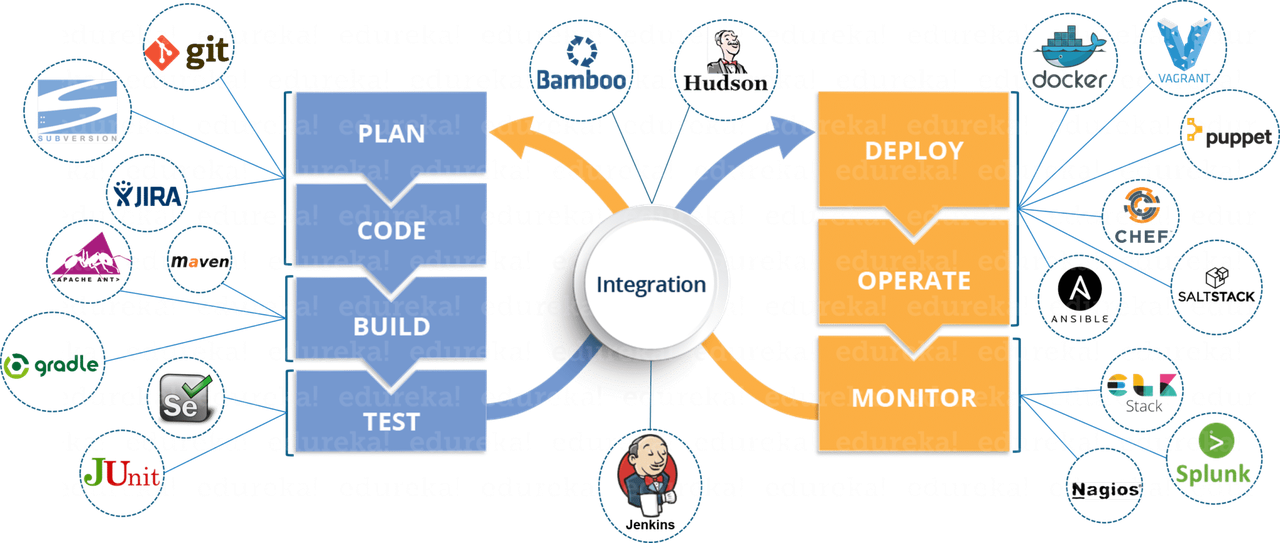Continuous Integration (CI) is a set of good practices that combines the work of multiple developers. It has the function of detecting integration errors as soon as possible and analyzing the quality of the software. (See more about Continuous integration)
Continuous integration tools can be integrated with each other to generate a workflow. Some used tools are:

Figure 1: Herramientas para la Integración Continua
Source: https://www.edureka.co/blog/devops-tools
Jenkins
Jenkins is a self-contained, open source automation server written in Java which can be used to automate all sorts of tasks related to building, testing, and delivering or deploying software (Jenkins, 2020).
Jenkins can be used with different projects in a wide variety of languages and technologies besides Java, such as C, Python, Ruby, .NET, Groovy, Grails, PHP, and more. Jenkins can also be used with a large number of construction tools, such as Ant, Maven, Kundo, Gradle, etc.
More about Jenkins
Gitlab
GitLab is a web-based git repository manager that allows teams collaborate on code, create and edit projects. It encompasses version control, continuous integration (CI), Continuous delivery (CD), project management, and DevOps work flows.
More about GitLab
SonarQube
SonarQube is an open source platform which manages the source code quality. It is implemented in Java language and covers 27 different programming languages.
It integrates properly with continuous integration tools like Jenkins, making it possible to automate analysis every time a developer uploads code.
More about SonarQube
Nexus
Nexus is an open source repository manager that can analyze the components used in software development, their security and licensing features. When integrated with a continuous integration server, it becomes a dynamic and regular analysis and potentially occurs with every compilation that runs on the server.
More about Nexus
Apache Maven
Apache Maven is a management tool for Java projects. Maven builds a project using its project object model (POM), which describes the project, manages dependencies, and configures plugins for building the software. Its set of plugins make Maven a popular option for CI / CD.
More about Apache Maven
Docker
Docker is an open source platform for building, deploying, managing and running applications by using containers. These containers have libraries, system tools, code, and runtime that ensure the code will run in any environment.
More about Docker
CircleCI
A continuous integration and delivery platform that automates the build, test, and deploy of the software development process. CircleCI supports any language that runs on Linux such as Python, Node.js, Ruby, Java, Go, etc
More about CircleCI
Travis CI
A distributed and hosted continuous integration service. It is used to build and test software projects hosted on GitHub. It also simplifies testing and deployment of the app. It supports most programming languages, including Python, Ruby, Node, Java, Go and others.
More about Travis CI
Sources
Adrián Alonso Vega (2017). Medium. En: <https://medium.com/@alonsus91/invirtiendo-en-calidad-an%C3%A1lisis-est%C3%A1tico-con-sonarqube-cb2ea1f383b9> (20/04/2020)
Apache Maven (2020). En: <http://maven.apache.org/>.
Circle CI (2020). En:<https://circleci.com/#>
Crilly, Michael (2019). “What is GitLab”. En: <https://opsfactory.com.au/what-is-gitlab/>, (21/04/2020).
Docker (2020). En: <https://www.docker.com/>.
Ferguson Smart, John Jenkins (2011). The Definitive Guide: Continuous Integration for the Masses. United States of America: O'Reilly Media, Inc.
GitLab (2020). En: <https://about.gitlab.com/>.
Glossarytech (2019). “Travis CI”. En: <https://glossarytech.com/terms/tools/travis-ci>.
Jenkins (2020). “Jenkins User Documentation”. En: <https://jenkins.io/doc/>, (21/04/2020).
Nexus (2020). En: <https://www.sonatype.com/products-integrations>.
Open Source (2019). “What is Docker?”. En: <https://opensource.com/resources/what-docker>. (21/04/2020)
SonarQube (2020). En: <https://www.sonarqube.org/>.
SonarSource (2020). “SonarQube”. En: <https://www.sonarsource.com/products/sonarqube/>
Travis CI (2020). En: <https://travis-ci.com/>

